Commissioner of Indian Affairs Ezra A. Hayt's letter to Richard Henry Pratt communicating that it is unnecessary to recruit more children from the Pine Ridge Agency to attend the Carlisle Indian School. Hayt says that he does not think it best to take more young people from their home at present time. Hayt also lets Pratt know that he…
Hampton Normal and Agricultural Institute
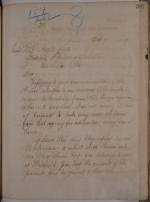
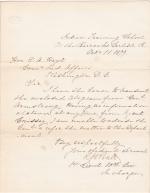
Richard Henry Pratt forwards to Commissioner of Indian Affiars Ezra Hayt a telegram sent by General Samuel Armstrong of the Hampton Institute. Armstrong telegrams Pratt asking whether he (Armstrong) is needed for a recruitment trip to Dakota, and Pratt forwards the telegram to the Commissioner for consultation.
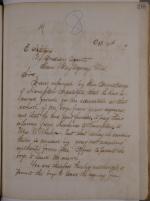
Letter from Commissioner of Indian Affairs Ezra E. Hayt to Indian Agent E. Stephens at Green Bay Agency authorizing him to recruit two Menominee boys from Keshena to go to Hampton Institute, payment for which had already been sent along to Mrs. W. Wheeler from General Armstrong. Hayt also suggests that he might meet up with Indian Agent Charles…
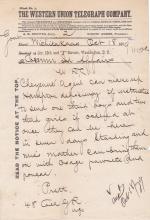
Richard Henry Pratt telegrams the Commissioner of Indian Affairs, informing him that the Cheyenne agent can supply students to make up the deficiency of students at Hampton, and should be instructed to send one third boys and two third girls. Pratt notes that these students could be escorted east by Alfred Standing and Sarah Mather, two…
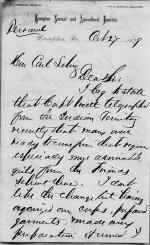
Hampton Institute Principal Samuel C. Armstrong informs Secretary of the Interior Carl Schurz that he received a telegraph from Captain Richard H. Pratt, who is currently in the Indian Territory. Pratt stated that there are many Indian girls in the Indian Territory who would be suitable students at Hampton. Armstrong states that, though he…
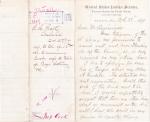
Letter from Richard Henry Pratt to Commissioner of Indian Affairs Ezra Hayt, acknowledging receipt of change orders allowing Pratt to remain in the East at the Carlisle Indian School. Pratt also apologizes for troubles during his recent trip to Wichita, and suggests that better planning be made for subsequent recruitment trips. Student…
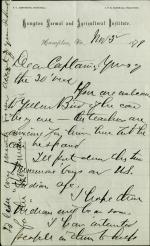
Samuel Chapman Armstrong of the Hampton Institute writes to Richard Henry Pratt about transferring some students, including Menominee boys and Yellow Bird, to Carlisle. Armstrong also discusses a visit to Carlisle on a trip north.
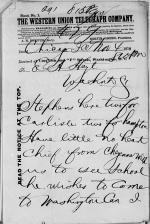
Agent Charles Crissey informs Commissioner of Indian Affairs E. A. Hayt that Agent Stephens is there with two students for the Carlisle Indian School and two for Hampton Institute. Crissey notes that he is also with Cheyenne Chief Little No Heart, who would like see the school. Crissey asks if he can bring Little No Heart with him.
Note…
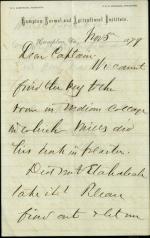
Samuel Chapman Armstrong of the Hampton Institute writes to Richard Henry Pratt inquiring whether Etadleuh still has the key to the Medium Cottage where Clark Mills took plaster casts of the heads of prisoners from Ft. Marion. Armstrong also discusses Hampton's capacity for Indian students.
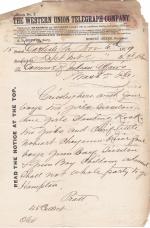
Telegram from Richard Henry Pratt noting the arrival of Agent Crissey with Sisseton, Standing Rock, and Cheyenne River Sioux children, Green Bay Menominee children, and Chief Little No Heart at Carlisle. Pratt suggests that all these children should be sent to the Hampton Institute.
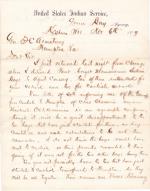
Richard Henry Pratt forwards to the Commissioner of Indian Affairs a letter, sent to General Samuel Armstrong of the Hampton Institute by Green Bay agent E. Stephens. Stephens requests that two students just sent to Carlisle, Joseph Wishecoppy [Wisecoby] and Moses Nonway, be sent to Hampton to join two other recently enrolled Menominee students…
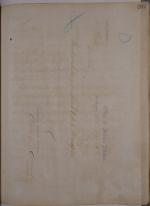
Telegram from Commissioner of Indian Affairs Ezra A. Hayt to Captain Richard Henry Pratt suggesting that he use his judgement about sending along to Hampton some of the students recently brought to Carlisle.
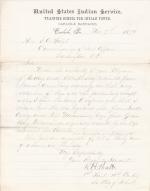
Richard Henry Pratt informs Commissioner of Indian Affairs Ezra Hayt that, at the request of Hampton Institute director General Samuel Armstrong, six Sisseton Sioux children and two Menominee boys from Green Bay, Wisconsin will be retained at Carlisle. Their addition increases the school's population to 158.
Note: The two Menominee…
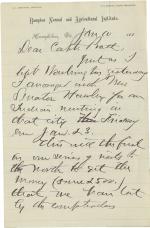
Samuel Chapman Armstrong of the Hampton Institute writes to Richard Henry Pratt informing him of a potential meeting between Armstrong and Senator Hawley to discuss money owed to Hampton by the government.
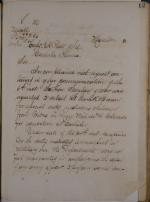
In this letter the Commissioner of Indian Affairs R. E. Trowbridge was responding to a from Indian Agent A. B. Ludlam of the Pima and Maricopa Agency's request for the education of three Pima boys at the Hampton Institute instead of at Forest Grove Industrial Training School in Oregon. Trowbridge explains that the climate is not much colder…
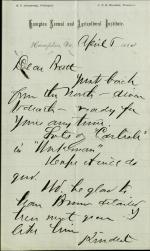
Samuel Chapman Armstrong of the Hampton Institute writes to Richard Henry Pratt letting him know that Hampton's newspaper, the Workman, contains several articles about Carlisle.
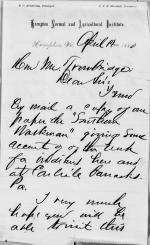
Wrapper for Samuel C. Armstrong's letter forwarding a copy of the newspaper, The Southern Workman, which details some of the work for Indians done at Hampton Institute and the Carlisle Indian School to the Commissioner of Indian Affairs Trowbridge.
Note: This item was copied from U.S. National Archives microfilm reels (M234), which were…
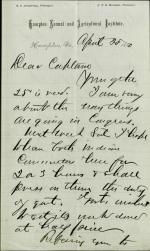
Samuel Chapman Armstrong of the Hampton Institute writes to Richard Henry Pratt sympathizing with Pratt's ongoing issues to gain political support for adequate funding for Indian education. Armstrong also criticizes the need for philanthropic funding, saying "referring you to private charity is shameful and disgusting."
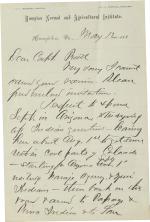
Samuel Chapman Armstrong of the Hampton Institute writes to Richard Henry Pratt discussing an upcoming trip to Arizona by way of Colorado and the Navajo agency, and requests advice for the trip.
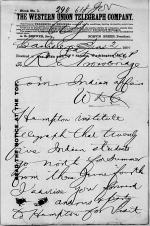
Richard Henry Pratt sends a telegram to Commissioner of Indian Affairs R. E. Trowbridge regarding 25 Hampton Institute students going north for the summer.
Note: This item was copied from U.S. National Archives microfilm reels (M234), which were filmed from the original documents found in Record Group 75, Entry 79, "Letters Received by…
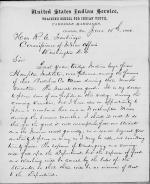
Richard Henry Pratt informs Commissioner of Indian Affairs R. E. Trowbridge that he would like students to have outings on farms located in Berkshire and Hampshire counties in Massachusetts. According to Pratt's plan, the Bureau of Indian Affairs would pay for the students' transit while students would pay for their food and washing expenses.…
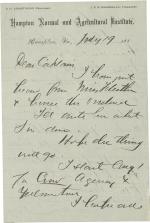
Samuel Chapman Armstrong of the Hampton Institute writes to Richard Henry Pratt discussing an issue with Miss Fletcher, and also discusses how instructors at Hampton have reacted to Pratt's work at Carlisle.
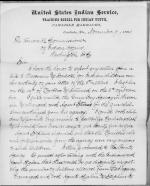
Richard Henry Pratt provides a report on his trip to Wisconsin and Dakota to recruit new students. Pratt notes that he first went to the Green Bay Agency and secured five students, but the enthusiasm among the parents was so strong that he could have easily recruited 25. Second, he visited the La Pointe Agency and instructed Green Bay Agent…
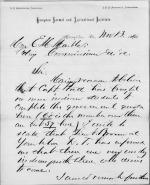
Samuel C. Armstrong informs Acting Commissioner of Indian Affairs E. M. Marble that Richard Henry Pratt is likely not bringing any new students to fill the quota of 68 Indian students at Hampton Institute. Armstrong continues to say that Lieutenant Brown at Yankton Agency knows of many Indian youth that would like to come to Hampton and could…
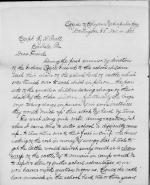
John D. Miles, Agent for the Cheyenne and Arapaho Agency, tells Richard Henry Pratt that his agency gave students cattle to take care of over vacation. As students did not know about the money and effort involved in caring for the animals, Miles relays a suggestion from John Holmes Seger (from the Arapaho school) that male students sell their…
